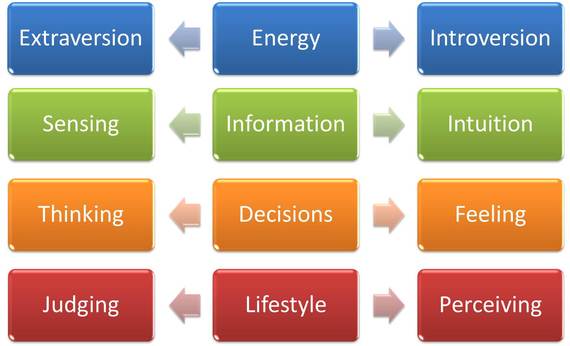MBTI or Meyers-Briggs Personality Theory started in the early 1900's and evolved through the years into a self-analyzing tool that in some circles is cult-like. Originally started as a means to understand one's affinities and abilities in the their career, it still has yet to reach its potential in the workforce. MBTI geeks utilize the personality test to find their love matches and to figure out why they never could get along with their cousin, Joe. In the workplace, they've used it to confirm they are in fact on the right career track or to inspire them to change careers.
The real benefit of understanding MBTI's potential in the workforce however, might require an organization to turn their talent pool on its head. (Not literally, but perhaps not a bad idea in some cases!) By going beyond awareness and identifying what MBTI means in terms of team and project interaction, your organization could be tapping into the hidden forces already in your workforce that just may be in the wrong cubicle at the wrong time.
MBTI identifies an individuals natural preferences in how they take in information in the world and how they make decisions. Cognitive functions are stacked in order of preference and are extremely telling as to what makes a person tick, in what circumstances they are most effective and what environment best taps into their inner potential.
There are 16 types made up up four letters: The Idealists (ENFJ, ENFP, INFJ, INFP); The Guardians (ESTJ, ESFJ, ISFJ, ISTJ); The Artisans (ISFP, ISTP, ESTP, ESFP) and The Rationalists (ENTJ, ENTP, INTJ, INTP)
- E/I represents extroversion or introversion: Extroverted individuals get their energy from others. Introverted individuals get their energy from alone time.
- N/S represents intuition or sensing: Intuitive individuals draw patterns from abstract information. Sensing individuals are in tune with their physical environment and experiential memories.
- F/T represents feeling or thinking: Feeling individuals make decisions based on personal values and the feelings of others. Thinking individuals are rational and value logic over all else.
- P/J represents perceiving or judging: Perceiving individuals like to keep their options open. Judging individuals like to have a framework to their work and their life.
Types with extroverted intuition (ENTP, ENFP) are your organization's brain stormers. They are the idea-people that can make intuitive connections and predictions for your business. They may get bored, however, with the finer details of bringing their ideas to fruition without a support team to carry their ideas through.
Thinking types, particularly thinking/judgers (INTJ/ENTJ), can spot inefficiencies in your organization almost to a fault. They are natural leaders that will set the project in motion. They may not always have the tact necessary in all employee situations and work great with a support staff to help them handle these finer details.
Sensing types are great with detail, aesthetics and task master roles (ISFP / ESFJ). They follow the rules. They are the ones making sure that all the finer details are getting done and that your workplace does not collapse while the rest of us are out to lunch.
Understanding the natural tendencies of the individuals on your team can allow for some great predictions. Matching personality types on projects where one person's strength is another person's weakness can bring out the best in everyone, allowing people to positively contribute as well as appreciate one another and get along. Why place two people with the same type on a project where it may create unhealthy competition? Placing your creative extroverts in the back room with no windows and no human interaction is sure to make them feel like drones and mute their creativity. Forcing your introverted rationals or introverted feelers to constantly deal with people may serve to frustrate them and stifle their best efforts from emerging from their work space.
If I were to start a small business developing a competitive product, I would be sure an ENTP was on my strategy team, a TJ was leading the charge, an NF was on my marketing team (with lots of open space!) and an SJ was managing the office dynamics. This is surely a broad brush stroke; but, I definitely believe in the potential of MBTI in terms of going beyond the oft used what-do-I-want-to-be-when-I -grow-up application of this personality model.
I believe with the right MBTI expert on your team, you may be able to alleviate conflicts, spark energy where things have gotten stagnant, build momentum in your doldrums and re-energize people into making contributions that are meaningful to them personally.
Have you tapped into your organization's true workforce potential?
Do you know what makes each of your employees tick?
Do you know their type?

